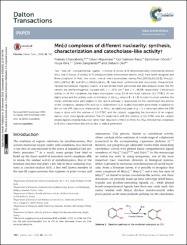| dc.contributor.author | Chakraborty, Prateeti | |
| dc.contributor.author | Majumder, Ishani | |
| dc.contributor.author | Banu, Kazi Sabnam | |
| dc.contributor.author | Ghosh, Bipinbihari | |
| dc.contributor.author | Kara Subaşat, Hülya | |
| dc.contributor.author | Zangrando, Ennio | |
| dc.contributor.author | Das, Debasis | |
| dc.date.accessioned | 2020-11-20T15:03:50Z | |
| dc.date.available | 2020-11-20T15:03:50Z | |
| dc.date.issued | 2016 | |
| dc.identifier.issn | 1477-9226 | |
| dc.identifier.issn | 1477-9234 | |
| dc.identifier.uri | https://doi.org/10.1039/c5dt03659c | |
| dc.identifier.uri | https://hdl.handle.net/20.500.12809/2790 | |
| dc.description | WOS: 000367312900042 | en_US |
| dc.description | PubMed ID: 26630495 | en_US |
| dc.description.abstract | Two "end-off" compartmental ligands, 2-formyl-4-chloro-6-N-ethylmorpholine-iminomethyl-phenol (HL1) and 2-formyl-4-methyl-6-N-ethylpyrrolidine-iminomethyl-phenol (HL2) have been designed and three complexes of Mn(II), one mono-, one di-and a polynuclear, namely Mn(L1)(SCN)(2)(H2O)] (1), [Mn-2(L1)-(OAc)(2)](BPh4)] (2), and [Mn-2(L-2)(OAc)(2)(dca)](n) (3) have been synthesized and structurally characterized. Variable temperature magnetic studies of 2 and 3 have been performed and data analyses reveal that Mn centers are antiferromagnetic coupled with J = -9.15 cm(-1) and J = -46.89, respectively. Catecholase activity of all the complexes has been investigated using 3,5-di-tert-butyl catechol (3,5-DTBC). All are highly active and the activity order on the basis of the k(cat) value is 2 > 1 > 3. In order to unveil whether the metal centered redox participation or the radical pathway is responsible for the catecholase-like activity of the complexes, detailed EPR and cyclic voltammetric (CV) studies have been performed. In addition to the six-line EPR spectrum characteristic to Mn(II), an additional peak at g similar to 2 is observed when the EPR study is done with the mixture of 3,5-DTBC and the catalyst, suggesting the formation of an organic radical, most likely ligand centered. The CV experiment with the mixture of 3,5-DTBC and the catalyst reveals ligand centered reduction rather than reduction of Mn(II) to Mn(I). It is thus inferred that complexes 1-3 show catecholase-like activity due to radical generation. | en_US |
| dc.description.sponsorship | CSIR, New DelhiCouncil of Scientific & Industrial Research (CSIR) - India [01(2464)/11/EMR-II]; UGCUniversity Grants Commission, India [UGC/729/Jr Fellow(Sc)] | en_US |
| dc.description.sponsorship | The authors wish to thank CSIR, New Delhi [01(2464)/11/EMR-II dt16-05-11 to D. D.] for financial support and the University of Calcutta for providing the facility of the single-crystal X-ray diffractometer from the DST FIST program and for collecting variable temperature magnetic study from SQUID-VSM in CRNN. Authors are also thankful to Prof. Shyamal Kumar Chattopadhyay of IIEST, Shibpur for providing the facilities for electrochemical studies. I. M is thankful to UGC [UGC/729/Jr Fellow(Sc)] for providing a fellowship. | en_US |
| dc.item-language.iso | eng | en_US |
| dc.publisher | Royal Soc Chemistry | en_US |
| dc.item-rights | info:eu-repo/semantics/openAccess | en_US |
| dc.title | Mn(II) complexes of different nuclearity: synthesis, characterization and catecholase-like activity | en_US |
| dc.item-type | article | en_US |
| dc.contributor.department | MÜ, Fen Bilimleri Enstitüsü, Fizik Ana Bilim Dalı | en_US |
| dc.contributor.institutionauthor | Kara Subaşat, Hülya | |
| dc.identifier.doi | 10.1039/c5dt03659c | |
| dc.identifier.volume | 45 | en_US |
| dc.identifier.issue | 2 | en_US |
| dc.identifier.startpage | 742 | en_US |
| dc.identifier.endpage | 752 | en_US |
| dc.relation.journal | Dalton Transactions | en_US |
| dc.relation.publicationcategory | Makale - Uluslararası Hakemli Dergi - Kurum Öğretim Elemanı | en_US |


















